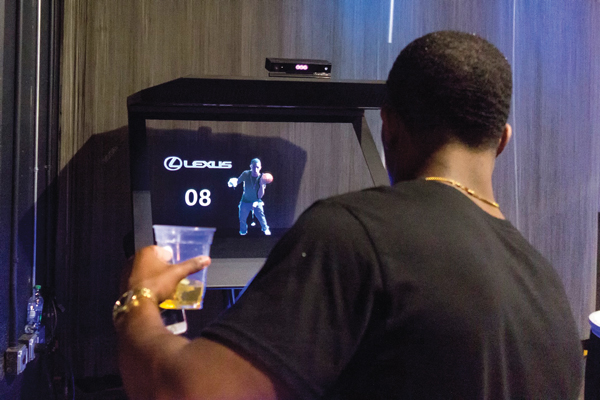Holograms in sports have largely revolved around life-size images of celebrities, whether it’s hitting with “Maria Sharapova” at the U.S. Open or listening to a “Vince Lombardi” pep talk at the Pro Football Hall of Fame.
Now holograms are offering a new way to advertise in sports arenas.
Over the last few months, Lexus has used the technology on premium-seating levels at Staples Center, MSG, the United Center and Verizon Center — it has its name on suite levels or clubs at all of them — to activate its sponsorship and show off its cars, saying it doubled dealers’ leads in L.A. alone.
Users were able to see themselves on the platform spinning balls on their fingers, or they could play a memory game that revolved around car parts. Lexus worked with its luxury brand agency, TeamOne, in securing the hologram technology. The brand did not reveal the cost.
“This is basically just a new type of display to advertise on,” said Ashley Crowder, co-founder and CEO of Vntana, the hologram technology company. “We are working on deals to install it in venues, and the venues can sell advertising space just like they do on an LED wall, but it is an interactive hologram that collects data, that has social sharing.” Data collected includes biographical information such as gender, age and occupation.
 |
Lexus has frequently used the technology in its sports marketing.
Photo by: VNTANA
|
This marks a continued effort in using augmented reality technology both for events and at facilities. Lexus has used augmented reality throughout the country in multiple venues, but this is the first hologram experience brought to sports sponsorships.
A user stands in front of the display, and then appears in it as a tiny figure (think Mike Teavee in “Charlie and the Chocolate Factory” being shrunk into a television). The person can then interact with an augmented insertion, whether a spinning basketball or a celebrity. Vntana had a popular display at the Super Bowl’s NFL Experience where kids could dance on screen with SpongeBob SquarePants.
Lexus is likely to use the technology again after this NBA season given the success, said Rebecca Buer, Lexus dealer advertising manager.
“It gives us a great capacity to showcases vehicles” in spaces where they are physically not permitted, she said. Before engaging with the games, users see displays of the cars.
“This technology has really been great for delivering the premium experience to our most affluent fans,” she said.
Lexus would not say precisely how many extra leads its dealers got from the prior year activation at Staples Center, which for that season was a game console. But it is believed to be high hundreds if not thousands more.
Vntana owns the data that is collected and, depending on the contract, shares or can sell it to the brand.
Founded in 2012, Vntana got its start in the music business. Crowder, who DJed at night while working as an engineer at BP, realized holograms could allow musicians to play multiple venues at once. Lifesize holograms are more standard in the music business, where the technology first got attention.
Vntana’s early endeavors were sponsored by brands, and conversations soon begun on how the companies themselves could use the technology, Crowder said.
“Sports has really become a big niche for us because we can provide these VIP experience that were never possible before,” she said.
The company does the traditional life-size hologram as well. It worked with Mercedes-Benz at the 2015 U.S. Open Tennis Championships so fans could receive a serve against Roger Federer. The Pro Football Hall of Fame uses the company for the permanent hologram display of inductees, alive and dead.
Recently, Nike hired the company for a uniform unveiling for the eight high school teams that play at the Dallas Cowboys Star complex in Frisco. When the players walked to their lockers, Crowder said, their uniforms came through the floor as a hologram.
For sponsor activation, Crowder views the technology used as Lexus does, or for more static advertising displays in venues. With Lexus, Vntana got into the arenas as a vendor of the car brand, but going forward the firm is negotiating directly with arenas and stadiums.




